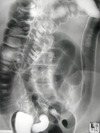Inflammatory Bowel Disease Flashcards
What are the two major forms of IBD?
- Crohn’s Disease
- Ulcerative colitis
What environmental factors are associated with the development of IBD?
- Smoking
- NSAID ingestion
- Hygeine
- Nutrition
What is thought to be the primary cause of IBDs?
Inappropriate immune response against the gut flora in a genetically susceptible individual
How much does smoking increase the risk of developing IBD?
3-4x the risk
What is ulcerative colitis?
Relapsing/Remitting inflammaotyr disorder of the colonic mucosa. It may affect the rectum, or extend to involve part of the colon, or the entire colon. It never spreads proximal to the ileocaecal valve (except for backwash ileitis)
What are the main sites the ulcerative colitis occurs?
- Proctitis - rectum
- Left-sided colitis
- Pancolitis - whole colon

What are the pathological features of UC?
- Hyperaemic/Haemorrhagic colonic mucosa +/-pseudopolyps
- Punctate ulceration - extends deep into lamina propria

What distinguishes UC from Crohn’s Pathologically?
- Crohn’s is transmural, whereas UC is primarily mucosal
- Granulomas are often present in Crohns

What are the pathological features of Crohn’s Disease?
- Granulomas
- Fissuring ulceration
- Focal/Patchy mucosal involvement
- Neuromuscular hypertrophy

Which IBD does skip lesions occur in?
Crohn’s - areas of unaffected bowel between areas of active disease
Which IBD does backwash ileitis occur in?
UC - usually in pancolitis
What is the difference in terms of the affected bowel between Crohn’s and UC?
- Crohn’s - Thickened wall + strictures/narrowed lumen
- UC - Ulcerated wall with dilated lumen

Which IBD produces granulomas?
Crohn’s

Which type of IBD tends to fistulate more commonly?
Crohn’s

Which type of IBD are more at risk of cancer?
UC

Why does the bowel wall thicken in Crohn’s?
Due to oedema and fibrosis
What are symptoms of UC?
Episodic attacks
- Diarrhoea (episode/chronic) +/- blood/mucus
- Crampy abdominal discomfort
- Increased frequency
- Urgency +/- tenesmus
- Systemic features in attacks - fever, malaise, anorexia, weight loss
What signs may be present in someone with UC?
May be none. If presenting during an attack:
- Fever
- Tachycardia
- Tender, distended abdomen
Extraintestinal signs (chronic)
What extraintestinal signs may be seen in IBD?
- Clubbing
- Erythema nodosum
- Pyoderma gangrenosum
- Conjunctivitis
- Uveitis/Episcleritis/Iritis
- Large joint arthritis
- Sacroiliitis
- Ankylosing spondylitis/inflammatory back pain
- PSC
- Nutritional defects
- Venous thrombosis
What is the following seen in?

Pyoderma gangrenosum
- Idiopathic: 25–50% of cases
- Inflammatory bowel disease: up to 50% of cases
- Rheumatological disease
- Paraproteinaemia
- Haematological malignancy
What is the following?

Erythema nosodum - A skin disorder of acute onset with eruption of red, tender nodules and plaques, predominantly over the lower extremities, especially the extensor surfaces. It is a form of panniculitis
What is the mechanism behind erythema nodosum?

In theory, immune complexes form after exposure to an antigen and are deposited in venules around areas of subcutaneous fat and connective tissue. The subsequent inflammation causes the lesions.
Why the lesions appear so frequently on the shins has not been explained - suggested that a combination of a relatively meagre arterial supply combined with gravitational effects on venous system gravitational favour deposition in that area
What are causes of the following?

- Inflammatory bowel disease
- Infections – streptococcal, tuberculosis, URTIs, yersiniosis
- Sarcoidosis
- Rheumatological disorders
- Drug reactions – usually sulfonamides and the oral contraceptive pill
- Malignancies
- Pregnancy
What is the following?

Clubbing


























